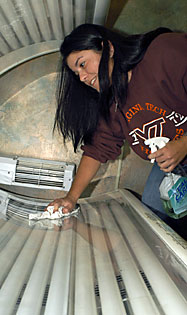 |
|
MICHAEL GIDALY/Arizona Daily Wildcat
|
Taryn White, a political science sophomore, cleans a tanning bed at Sunsations tanning Center, 1708 E. Fort Lowell Road, for its next use. A recent study by the Journal of the National Cancer Institute showed frequent The tanning bed use can increase a person's risk of developing malignant melanoma, a sometimes fatal skin cancer.
|
|
|
By Erin Schmidt
Arizona Daily Wildcat
Friday, November 7, 2003
Students heading off to the tanning salon to bake in the sunlamps may have more than just tan lines to worry about.
Frequent trips to the tanning salon can increase your risk of malignant melanoma, a sometimes fatal skin cancer, reported a study in the Journal of the National Cancer Institute.
The study surveyed the lifestyles of women from Sweden and Norway, between the ages of 30 and 50.
In 1991 and 1992, 106,379 women began the survey that looked at their history of exposure to sunlight and tanning bed usage. In 1999, the researchers followed up on the women through the national health registries in Norway and Sweden.
They found that 187 cases of malignant melanoma had been diagnosed among women over a period of eight years. They also found that women who frequent a tanning salon at least once a month increased their chances of developing skin cancer by 55 percent.
Women between the ages of 20 and 29 were at a 150 percent risk of developing skin cancer if they used a tanning salon at least once a month.
"Adolescence and early adulthood appear to be among the most sensitive age periods for the effect of sunburn and solarium use on melanoma risk," the survey's authors wrote.
Melanoma is the most common form of skin cancer. Exposure to ultraviolet rays is believed to increase a person's chances of getting melanoma.
Melanoma can cause changes in the shape, size or color of a pre-existing mole, according to the American Academy of Dermatology Web site. More than 50,000 cases of melanoma are diagnosed each year.
Melanoma is curable if detected early. When the cancer has grown, it can spread to the lymphatic system and eventually throughout the whole body.
If the disease is not detected early, it can lead to death. An estimated 7,800 people die annually in the U.S. of melanoma, according to AAD statistics from 2001.
Lee Ann Hamilton, a UA campus health educator who is a survivor of skin cancer, said melanoma is most common in people who have fair hair and fair complexions, but she added that everyone is at risk.
"Sun damage is cumulative, even as far back as third grade" Hamilton said. "A tan is a sign of damaged skin."
Hamilton said that when students repeatedly tan, their skin suffers.
"A tan is your skin trying to protect you from damage," Hamilton said. "When your skin gets injured that is when you get a tan."
Alicia Schaefer, a music junior, said she has never been in a tanning booth before, and because the parents of two of her good friends died of skin cancer she doesn't think she will ever go in one.
"I think it leads to skin cancer," Schaefer said. "I think it is more important to be healthy as an adult, than tan when you're in college."
Gretchen Ward, an employee at Maui Beach tanning, 4675 E. Speedway Blvd., said many UA students tan on a regular basis in the shop's tanning beds.
Regular tanners can come in as much as three to five times a week, she said. She said many clients just don't have time to lie out in the sun to get a tan.
Ward would not comment on whether the use of tanning beds increases the risk of skin cancer, but she did say the 20-minute limit in the tanning beds gives clients more control than if they were sunbathing.
"Someone can lay out in the sun for hours and get fried," Ward said. "Our beds are much more controlled."
Aimee Gowler, a pre-pharmacy freshman, said she used to use tanning beds but has stopped.
"My grandmother died of skin cancer," Gowler said. "After that I realized tanning beds weren't for me."
Gowler, who is blonde and fair-skinned, said she uses sunscreen to protect herself from the harsh Tucson sun.
"I always carry it around with me," Gowler said. "It is just a precaution that I have to take."
And for those who want the tan without the sun exposure, a new trend is replacing the use of tanning beds with a mist.
Leigh Grissom, the manager of Sun Mist, of 3013 E. Speedway Blvd., specializes in a combination sunless tanner and bronzer, which is sprayed on the skin.
Grissom said the tan lasts for five to seven days and provides an even tan.
"Many dermatologists are putting the tanning mist machines in their offices," Grissom said. "You can get a nice tan without the damage of the sun."
